Mark Sisson's Blog, page 341
April 28, 2013
Weekend Link Love
 Texans, we’ve got a few openings left for the upcoming Primal Blueprint Transformation and True Nature Training Seminars in Austin on May 4 and in Houston on May 5. Learn how to live Primal and move naturally!
Texans, we’ve got a few openings left for the upcoming Primal Blueprint Transformation and True Nature Training Seminars in Austin on May 4 and in Houston on May 5. Learn how to live Primal and move naturally!
Research of the Week
A new study finds that markers of long-term stress (hair cortisol) correlate just as strongly to cardiovascular disease as traditional CHD risk factors.
Sunbathing mushrooms – the new vitamin D supplement?
Beards protect your face from sun damage, collect dust and pollen that would otherwise reach your nose, and help you retain moisture, according to science. You can expect me fully and lustrously bearded at the next PrimalCon.
Interesting Blog Posts
MDA reader Paul Austin just penned an extensive, impressive post describing how to deal with gluten intolerance when on the road.
There’s another TMAO media uproar, this time about eggs and cardiovascular disease. Examine.com takes this one on.
Media, Schmedia
This fellow who appeared on Good Day LA to talk about Primal living looks awfully familiar.
Loren Cordain and Nell Stephenson recently appeared on Dr. Oz to discuss the paleo diet. Check out how it went down.
Everything Else
How one man stays healthy, stays young, and keeps his wits about him: endless, endless play.
Portly zoo grizzly bears who were placed on an ancestral bear diet (whole prey instead of hamburger meat and dog food, fibrous veggies instead of tropical fruit) shed tons of weight. Might people also benefit from “nature’s weight management program”?
Recipe Corner
Seriously, who can argue against using actual scallops in place of sandwich bread?
I’m always up for a good frittata recipe, like this sausage and butternut squash frittata.
Time Capsule
One year ago (Apr 28 – May 4)
Is It Primal? – Coconut Water, Chocolate Milk, Glycomaize and Other Foods Scrutinized – In which I kick off the “Is It Primal?” series of posts with ten questionable foods.
Why We Don’t Walk Anymore (plus a Primal Health Challenge) – People don’t walk nearly as much as they used to – or should. Here’s why, and what to do about it.
Comment of the Week
Gluten free is just the next Conventional Wisdom bullpuckey…these folks will try anything to get us! But that grilled cheese Mark mentions sounds so darned good, LOL!
- That’s exactly how they get you, Nocona! It’s all part of the plan.
Get All Three Primal Cookbooks, an Apron and More in The Primal Blueprint Chef Kit Today!

April 27, 2013
Philly Cheesesteak (with Optional Primal Cheddar Cheese Sauce)
 As it turns out, Philly Cheesesteak is an amazing meal even if it’s just Philly Steak. Meaning, no cheese sauce or bread included. Not authentic, but delicious none-the-less. You really can’t go wrong with thinly sliced rib eye topped with caramelized onions, sautéed mushrooms and peppers.
As it turns out, Philly Cheesesteak is an amazing meal even if it’s just Philly Steak. Meaning, no cheese sauce or bread included. Not authentic, but delicious none-the-less. You really can’t go wrong with thinly sliced rib eye topped with caramelized onions, sautéed mushrooms and peppers.
Philly Cheesesteak isn’t about fancy seasonings and preparation methods. Salt and pepper is all you need. Sear the thinly sliced steak for only a minute, sauté the mushrooms and peppers until tender, and cook the onions until brown and sweet. Then pile it all high on plate – Philly Cheesesteak isn’t about dainty serving sizes.
If you’re passionately opposed to Philly Cheesesteak without cheese sauce and you tolerate dairy, then there’s something here for you too: a decadent cheese sauce made with real cheese and no starchy thickener of any kind. (Or, forget about making cheese sauce and just melt a slice of really good cheddar or aged provolone on top.)
Serves: 4
Time in the Kitchen: 1 to 1 1/2 hours
Ingredients:
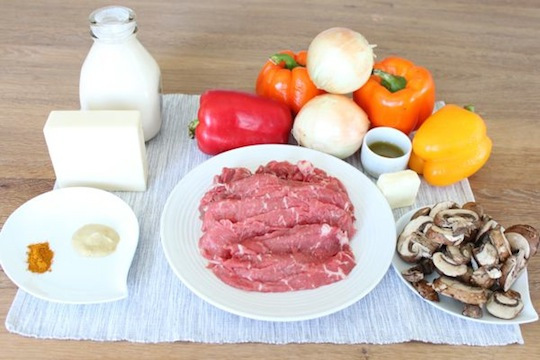
2 tablespoons butter (30 ml)
2 large yellow onions, sliced thinly
2 to 2 1/2 pounds rib-eye or other tender, boneless steak (900 g)
3 tablespoons olive oil (45 ml)
1 pound mushrooms (450 g)
4 bell peppers, sliced thinly
Salt and Pepper
Cheese Sauce (Optional)
1 cup whole/heavy cream (240 ml)
1 tablespoon Dijon mustard (15 ml)
1 cup grated sharp Cheddar cheese (90 g)
A pinch of turmeric (optional, it’s just for color)
Instructions:
Melt the butter in a wide pot over medium heat. Add the onions and cook, stirring only occasionally, until they are soft and deeply browned, 30 to 45 minutes. If the onions start getting too dark, turn the heat down to medium-low. Add salt and pepper to taste.
Once the onions start cooking, put the steak in the freezer for 30 minutes. This makes the meat easier to slice thinly. Once it’s out of the freezer, slice the meat as thinly as possible.
Put the sliced steak in a large bowl and toss lightly with a little bit of olive oil and generously season with salt and pepper. Set aside.
In a wide skillet, heat 3 tablespoons of olive oil over medium heat. Add the mushrooms and cook for 5 minutes. Add the peppers and cook the mushrooms and peppers until tender, 10 to 20 minutes more. Add salt and pepper to taste.
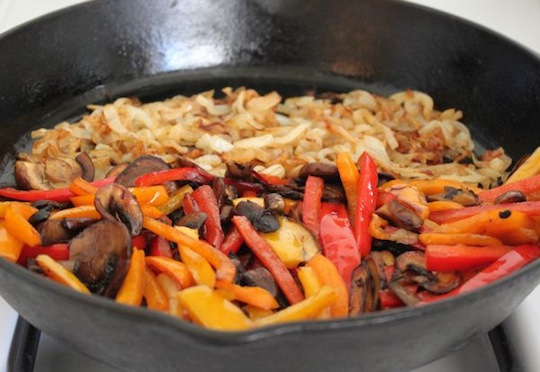
Heat a skillet (ideally, cast iron) over high heat. When it’s hot, add the pieces of steak, cooking for only about 30 seconds a side.
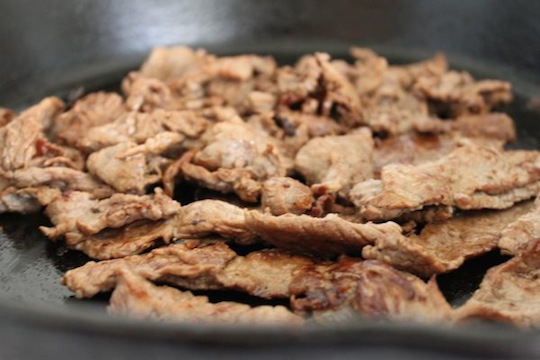
Pile the steak up on a plate. Top with onions, mushrooms and peppers.
To make the cheese sauce: Bring the cream to a gentle simmer in a skillet over medium, or just a notch below medium, heat. Stir frequently with a rubber spatula, scraping the bottom and sides of the skillet so the cream doesn’t burn. After 5 minutes stir in the mustard. The sauce will start to thicken. Stir constantly while the sauce simmers for another 2 to 3 minutes. Turn off the heat. Slowly add the cheese, stirring vigorously to help it melt completely. Add turmeric if desired for color.
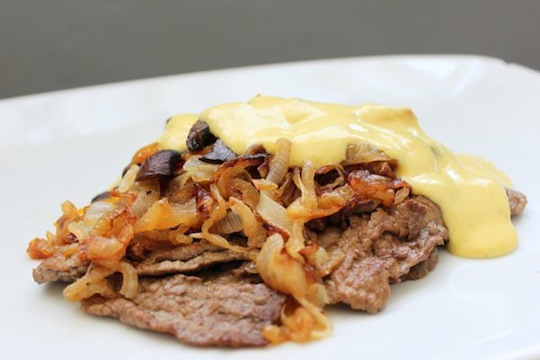
Not Sure What to Eat? Get the Primal Blueprint Meal Plan for Shopping Lists and Recipes Delivered Directly to Your Inbox Each Week

April 26, 2013
I Was Astounded at How Quickly the Weight Came Off and Stayed Off
It’s Friday, everyone! And that means another Primal Blueprint Real Life Story from a Mark’s Daily Apple reader. If you have your own success story and would like to share it with me and the Mark’s Daily Apple community please contact me here. I’ll continue to publish these each Friday as long as they keep coming in. Thank you for reading!
 Hello Mark,
Hello Mark,
I’ve been wanting to send in my story for a long time but I think I was waiting for a “happy ending” before I felt I could put it out to the world. I finally feel like I’m in a great place to send this out, though I would hardly consider it an ending.
My unhealthy relationship with food starts at the age of ten or eleven. I was swimming several times a week, so I was not overweight – but my eating habits were putting me on a track of a lifetime of unhealthy eating. I would come home from school before anyone else in my family and eat an entire bag of chips or candy and hide the evidence, because even at the age of ten I realized that this was an odd thing to do, and felt guilty about it.
At the age of thirteen my family moved across the continent and I stopped swimming. The absence of physical activity, and bad snacking habits coupled with depression all caught up with me. I steadily gained weight and thought nothing of it.
By the time I started high school, I made more friends and got to a generally happier place, but the bad eating habits had settled in. I remember loving the weekends when I was baby-sitting because I could snack on junk food while the kids were in bed. I was 5’7″ and around 160 pounds. This isn’t a bad weight to be at for the average woman, but for a 16 year old this was well outside of my comfort zone. I was really unhappy with seeing that number on the scale, but had no idea what to do about it.

During University, I decided to be a vegetarian. This involved eating a lot of grilled cheese sandwiches and french fries while on the school meal plan. By the end of the holiday season after my first semester of art school, I had hit 175 pounds. That was my limit. I still had no idea of what to do about it, but I figured limiting the french fries and pop tarts was a solid start. By the end of the school year I had lost 15 pounds just by making slight changes. And I do mean slight – I was still eating the grilled cheese sandwiches, I was just not also eating Oreos.
Over the next summer, at the age of 18, I decided I wanted to get more serious about my health. I looked up the government calorie count website and calculated my meals religiously. My goal was 1200 calories a day, and I was usually thrilled if I came in under that. I also spent hours walking on the treadmill and went swimming several times a week. To the calculator’s credit, it was consistently telling me I was not getting enough calories – I took that as a win. An interesting thing to note was that though I had been a vegetarian for a year at this point, I started craving meat after my swim sessions – once or twice I gave in and snuck a few pieces of turkey when no one was around and immediately felt guilty about it. Over that summer I lost thirty pounds, but even though I was a healthy and happy weight, I still had sugar-obsessed eating habits coupled with a desire to keep losing weight. I would spend one day eating fluffernutter sandwiches and then do a juice fast the next.
In 2008, I spent a semester abroad in France, and the vegetarianism and food paranoia couldn’t hold out against all of the delicious meat, pastries, wine, and butter. I gained 10 pounds in that semester, but enjoyed every minute of it, for a change. Of course, when I came back I immediately began my old regime – with the addition of weekly running, purely with the intention to burn calories to make up for dietary trespasses.
Fast forward to just three years ago, I met a guy, and at the time of our meeting he had just lost 30 pounds and several inches off his waistline on the paleo diet. We started dating and really enjoyed cooking together and I perfected my grain/sugar free chicken tikka masala and the occasional paleo pancake.
Two years ago, the guy and I moved in together, and I finally read your book – not going to lie, it had been sitting on my nightstand staring at me for quite some time before I actually picked it up and read it. We decided to do a strict 30 day paleo challenge. During that time, my skin cleared up, and I lost weight without counting calories – a huge revelation for me.
Over the year, my commitment to eating paleo waxed and waned, but I had a much better idea of how to be healthy, and psychologically I was in a much better place. This January I started off the year by re-reading The Primal Blueprint and starting another strict 30 days of paleo and was astounded at how quickly the holiday weight came off – and stayed off. I also decided to join a local CrossFit gym. While I love the workout, I love the community more – I had never met other primal people out in the wild until then.
And that is where I am now. I no longer run or workout simply to reduce the circumference of my thighs, but just for the thrill of seeing what they are capable of. I can’t share my current weight – I ditched the scale several months ago, but my clothes fit and I’m happy. My now-fiancé and I still love to cook together, and eating is no longer something to be stressed out about or calculated, just something to enjoy.

All the best,
Amanda
Subscribe to the Mark’s Daily Apple Newsletter and Get the Success Story in the Making eBook for Free

April 25, 2013
11 Small Wins to Help You Kick Start Your Primal Life
 Last week I took up the idea of how small wins can lead to big successes. When we allow ourselves to appreciate the everyday accomplishments and set ourselves up for regular achievements, we inevitably gain confidence in our abilities and build the motivation to continue challenging ourselves. Ignoring a win is like brushing off a compliment: it’s a missed opportunity and a waste of positive energy. That energy matters more than we think in our journeys. When we shift the pattern and begin seeing – and celebrating – our small wins, however, we learn to literally see ourselves as winners (this doesn’t come easily for everyone), and as psychological reason goes, winning begets more success.
Last week I took up the idea of how small wins can lead to big successes. When we allow ourselves to appreciate the everyday accomplishments and set ourselves up for regular achievements, we inevitably gain confidence in our abilities and build the motivation to continue challenging ourselves. Ignoring a win is like brushing off a compliment: it’s a missed opportunity and a waste of positive energy. That energy matters more than we think in our journeys. When we shift the pattern and begin seeing – and celebrating – our small wins, however, we learn to literally see ourselves as winners (this doesn’t come easily for everyone), and as psychological reason goes, winning begets more success.
What constitutes a “win”? That’s up to you. Above all, start where you need to start. If you’re just embarking on a major weight loss or health overhaul, maybe every good choice deserves to be written down. Later, when better decisions become built into your lifestyle, you can raise the bar.
You can approach small wins a number of ways. Some people might prefer more of a “task” route in which you’re attempting to see how consistent you can be with a new habit. This approach cultivates discipline and can be helpful in laying down new patterns in your lifestyle. Make a game of it – especially if you’re doing it as a family or with Primal friends. Assign points for each task and compare at the end of the week/month. (Feel free to start a thread on the forum for it!) If it’s just your own groovy self, consider doing a log to give each task concrete, visual recognition.
Another way of looking at it is meeting a certain benchmark. These might feel more gratifying because they’re occasional achievements and therefore feel “bigger.” Additionally, there are challenges or events for which participation itself is the accomplishment for most people. Finally, there are the gains you make doing the same activity over time. It’s all part of a personal journey, of course, but consider incorporating a little of each.
Regardless of what wins you favor, there’s one thing I definitely suggest. The idea here is to see each win as part of a successive and progressive chain, a means for continual – and often exponential – growth. Don’t just observe each win individually like an isolated occurrence. To put each in a grander context and to get the most mental mileage out of your wins, assemble them. Keeping an ongoing record (e.g. achievement journal, visual board, fill-in calendar) will help you appreciate your progress over time. When you’re having a crummy day and suffer from selective amnesia about any past self-esteem or positive choices, you’ll have a whole slew of wins to buoy you through the funk.
Now, a few ideas for small wins worth cheering over:
Stepping down a dose in your medication (or stopping it altogether).
It’s one of the things people celebrate the most because it’s such a tangible sign that they’re regaining their health and vitality again from the grip of disease. No matter how small the change in dose, commemorate it. It’s your body getting stronger (and maybe your bank account more flush again).
Fitting into a new size or style of clothing.
Though we may claim otherwise, I think just about all of us enjoy looking good. Despite any culturally imposed guilt, there’s nothing wrong with it when it dovetails with being healthy. Some people have clothes from previous years they’d love to get into again. Others look forward to enjoying shopping for something new that they wouldn’t have felt comfortable in before. Whatever the case, work it.
Meeting a Foodie Challenge: Try 10 new Primal foods this month.
Expand your Primal repertoire and enjoy the win simultaneously. The key here is preparation. (A sad truth: healthy foods are the perishable ones.) Have a couple recipes for each new food that genuinely appeal to you. Take pictures of each creation. The more variety you develop in your Primal Blueprint diet, the more likely you are to feel satisfied and stick with it. Mikey likes it!
Keeping up with the kids.
I can’t tell you how many times I hear this from folks who go Primal. Extra weight and poor fitness had held them back so long, they felt like they were stuck on the sidelines of big parenting moments. The first time you realize you were able to catch your child in a game of tag or run alongside her as she rode her bike – you’ll never forget it. Appreciate the occasion for the fitness progress it is and the parenting celebration. You’ve always loved your kids. It’s just amazing to be present to them in a new, invigorated way.
Making it through a holiday/event without chucking your intentions.
Cousin’s wedding coming up? Spring charity galas or office retreats? Don’t underestimate the “win” of sticking with your Primal priorities at events like these. Go with a plan and celebrate the strength of your strategy and resolve afterward.
Hosting your own holiday/event – on your own Primal terms.
Unless they’re born with a penchant for entertaining, most people take their time on this one. It’s not your typical newbie event, but once you get the gumption to set the Primal agenda, it might just become tradition. No, maybe it won’t be easy to convince your non-Primal relatives to forgo the conventional trimmings for the bigger holidays like Thanksgiving, but consider hosting one of the upcoming “grill-friendly” holidays like Memorial Day or 4th of July. Primal hosting might not benefit your health specifically, but think of it as inspiration – living your Primal lifestyle out loud.
Achieving a fitness challenge.
Some people challenge themselves to try a new machine or set of weights at the gym each week. For others, it might be to try three new classes in a season. Maybe you want to challenge yourself to get out of the gym and attempt three kinds of outdoor or at-home workouts in a month. While physical gains (e.g. upping our lifting weight or treadmill incline, stepper time) are genuine small wins themselves, don’t forget to challenge yourself toward variety.
Filling five (or ten!) hours of play each week.
I honestly can’t think of a better win. How many people can say they play that much on a regular basis? How do you think people would feel about their lives if they did? Sure, not every hour of a Saturday can be filled with the likes of Ultimate Frisbee. Better to spread it out anyway. Turn off the T.V. and play chess instead on a Tuesday night. Skip an unnecessary meeting and woodwork or paint instead. Be active, creative, spontaneous. Get out of the mindset that governs all the other hours of the week – for five hours a week. The result can be life-changing.
Participating in a large fitness event.
There’s something to having an event on the calendar to work toward. It’s concrete initiative and hoopla-filled achievement on the actual day. Maybe it’s a charity walk that’s 3 miles or 10 miles. Maybe it’s your first 5K race or marathon. Maybe it’s a hiking trip or a noncompetitive biking expedition (Someone told me recently he does Iowa’s RAGBRAI each year – shout out to the Midwesterners.) Whatever the event, there’s such an incredible vibe you get from being with the other participants and seeing the supporters. It’s one of those small wins with huge personal gain – far beyond the exercise benefit.
Achieving a major calendar milestone.
Six months Primal, ten years Primal, one week Primal. Doesn’t matter – celebrate it. Mark the occasion with some reflection, a massage, or just your favorite Primal dinner.
Attaining an outdoor adventure challenge.
Choose five outdoor adventures in your area that you enjoy doing or have always wanted to do that you will hit between now and the start of summer. Then choose five more. They can include everything from hiking your favorite park trail to climbing an area mountain, tubing or canoeing a given river to doing a full moon hike, biking the rounds of your city to exploring a new neighborhood on foot. Mix it up and invite friends along for the adventure.
Is that enough to get you started? What other small wins would you add to the list? What small wins would you like to enjoy in the coming months? Thanks for reading, everyone. Have a great end to your week.
Limited Time Offer: Get a FREE Copy of The Primal Blueprint 90-Day Journal with Your Primal Essentials Kit Order

April 24, 2013
How Much Protein Should You Be Eating?
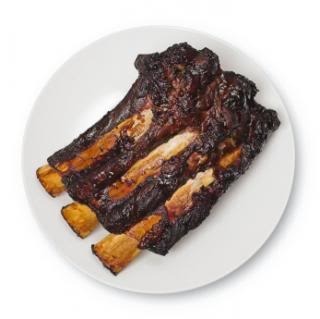 I get a lot of emails on a lot of subjects. “Mark, is toothpaste Primal?” “How many micrograms of wheat germ agglutinin can I safely consume each day?” “Did Grok even lift?” Usually, I manage to address them in the Monday Dear Mark posts, but sometimes a question deserves its own dedicated midweek post. Today’s question, or rather pair of questions, definitely qualifies. First is the titular question, “How much protein should I eat?” I get that one a lot, even though I’ve covered this in my books and in various blog posts. The second question is “How much protein do you eat, Mark?” Before we get to my protein intake (which has changed in recent years) let’s explore how much protein you should be eating. The answer – wait for it – depends on who (and what) you are. Your goals, your age, your activity levels, your size, and your health status all impact how much protein you need. And although individual protein requirements ultimately depend on dozens of variables that we can’t really know, there are some baseline intakes that can serve as a foundation for different groups. Let’s take a look.
I get a lot of emails on a lot of subjects. “Mark, is toothpaste Primal?” “How many micrograms of wheat germ agglutinin can I safely consume each day?” “Did Grok even lift?” Usually, I manage to address them in the Monday Dear Mark posts, but sometimes a question deserves its own dedicated midweek post. Today’s question, or rather pair of questions, definitely qualifies. First is the titular question, “How much protein should I eat?” I get that one a lot, even though I’ve covered this in my books and in various blog posts. The second question is “How much protein do you eat, Mark?” Before we get to my protein intake (which has changed in recent years) let’s explore how much protein you should be eating. The answer – wait for it – depends on who (and what) you are. Your goals, your age, your activity levels, your size, and your health status all impact how much protein you need. And although individual protein requirements ultimately depend on dozens of variables that we can’t really know, there are some baseline intakes that can serve as a foundation for different groups. Let’s take a look.
The Sedentary
The RDA of 0.8 g protein/kg bodyweight or 0.36 g protein/lb bodyweight assumes you are sedentary, uninterested in gaining muscle, and free of health issues that might compromise your lean mass. If that describes you, the RDA is a good baseline from which to experiment. Just don’t go below that.
The Active
Athletes need more protein than the average person, but perhaps not as much as most fitness enthusiasts think (or consume). A 2011 paper on optimal protein intakes for athletes concluded that 1.8 g protein/kg bodyweight (or 0.8 g protein/lb bodyweight) maximizes muscle protein synthesis (while higher amounts are good for dieting athletes interested in preserving lean mass), whereas another settled on “a diet with 12-15% of its energy as protein,” assuming “total energy intake is sufficient to cover the high expenditures caused by daily training” (which could be quite high). One study even found benefit in 2-3 g protein/kg bodyweight (0.9-1.4 g protein/lb bodyweight) for athletes, a significant increase over standard recommendations. That said, I wouldn’t be too quick to discount anecdotal evidence or “iron lore.” A significant-enough portion of the strength training community swears by 1-2 g protein/lb bodyweight that it couldn’t hurt to try if lower amounts aren’t working for you.
The Dieters
Weight loss involves a caloric deficit (whether arrived at spontaneously or consciously). Unfortunately, caloric deficits rarely discriminate between lean mass and body fat, while most people are interested in losing fat, not muscle/bone/tendon/sinew/organ. Numerous studies show that increasing your protein intake during weight loss will partially offset the lean mass loss that tends to occur. In obese and pre-obese women, a 750 calorie diet with 30% of calories from protein (about 56 grams) preserved more lean mass during weight loss than an 18% protein diet. Another study in women showed that a 1.6 g protein/kg bodyweight (or 0.7 g protein/lb bodyweight) diet led to more weight loss, more fat loss, and less lean mass loss than a 0.8 g protein/kg bodyweight diet. Among dieting athletes, 2.3 g protein/kg bodyweight (or a little over 1 g protein/lb bodyweight) was far superior to 1.0 g protein/kg bodyweight in preserving lean mass. And, although specific protein intake recommendations were not stated, a recent meta-analysis concluded that high-protein weight loss diets help preserve lean mass.
The Injured
Healing wounds increases protein requirements. After all, you’re literally rebuilding lost or damaged tissue, the very definition of an anabolic state. One review recommends around 1.5 g protein/kg bodyweight or close to 0.7 g protein/lb bodyweight for injured patients.
The Elderly
The protein RDA may not suffice for older people, who lose thigh muscle mass and exhibit lower urinary nitrogen excretion when given the standard 0.8 g protein/kg bodyweight. What’s good for the goose may not be good for the elderly, frail gander. More recent studies indicate that a baseline intake of 1.0-1.3 g protein/kg bodyweight or 0.5-0.6 g protein/lb bodyweight is more suitable for the healthy and frail elderly to ensure nitrogen balance. As always, active seniors will probably do better with slightly more, and evidence suggests that increasing protein can both improve physical performance without necessarily increasing muscle mass and increase muscle mass when paired with extended resistance training in the elderly.
These are just starting points, mind you. Guidelines. Play around with your protein intake.
I also get a lot of people asking me about my protein intake, and apparently some people have the idea that I’m eating entire racks of ribs for meals. Actually, though, I’ve slightly modified my protein intake over the past couple years. Or, rather, it’s more accurate to say that my protein habits have changed. It wasn’t really a conscious effort; it was a gradual shift that simply happened, spurred by my body’s own appetites. You might even say it was a Primal shift. So, what’s changed about how I eat protein?
I’m eating less meat. The urge to eat large steaks on a regular basis has simply diminished. I still might have meat at most meals, but I’m having 4-6 ounces at a sitting instead of 8-12. This wasn’t a conscious decision. The craving simply isn’t there, and I’m merely eating to appetite.
My protein intake is more cyclical, than regular. Some days, I’ll finish the entire steak and be ready for more. Other days (maybe most), I’ll have a few bites and save the rest for later.
I’m eating fattier, more gelatinous cuts, like short ribs, oxtails, and shanks and making bone broth more often. I’ve always enjoyed my animal fat, so that hasn’t changed, but the gelatinous focus is definitely newer. It may have been the Masterjohn “bones and skin” post from a few years back that got me thinking more about gelatin and spurred me to be more regular with the stock-making. After all, a cow isn’t just sirloin tips and ground beef. It’s bones and skin and organs and joints, too. A 1000 pound cow will provide about 430 pounds of “retail cuts” (PDF) – steaks, roasts, things like that. Some of the leftover is water weight, but the majority of the remaining 570 pounds is gelatin, offal, bones, skin, and other “waste products” that our ancestors certainly utilized. It’s only very recently – and in select places (ahem, United States) – that people began thinking of food animals as “meat” and nothing else. Demi-glace, consomme, pho, Jamaican oxtail stew anyone?
The end result is that while I’ve reduced my “meat” intake, I’m still eating a good amount of protein. It’s just that some of it is coming from broth and gelatin now, which have the effect of “protein sparing.” In other words, eating gelatin reduces the amount of meat required to maintain muscle mass and perform all my regular protein-related physiological functions. Adding more stock and gelatin-rich meats, particularly at dinner, has also seemed to improve my sleep. Eating the whole animal makes everything easier – who knew?
Anyway, I’m eating a bit less meat nowadays and a few more plants and odder animal bits, which may be a huge shock to some of you. You know why? My needs have probably changed and my body is responding accordingly.
I want to reiterate: this was not a conscious decision borne of theorizing. My “decision” to eat less meat has only happened because I crave it less. As to why my cravings might have diminished, I have a few ideas:
I’m no longer catabolizing my lean mass through excessive endurance training, nor am I actively recovering from it. Endurance athletics (and really, any activity, but especially catabolic training like marathons and triathlons) increases the need for protein. You’d better heed that need unless you like losing muscle and bone. Since I’m not doing Chronic Cardio anymore, I don’t need to eat so much to preserve my muscle.
I’m maintaining, rather than seeking to build more lean mass. There was a short stint of deliberate mass building several years ago where I overate (especially protein) and managed to get up to the mid 180s, but I didn’t enjoy it and maintaining that kind of lean mass was tough and required too much food. I’m happy where I am – both aesthetically and functionally – and so I don’t really have to eat a ton of protein to maintain.
My training is far more moderate than it ever was. I focus on play and strength training, but I mostly do bodyweight stuff (sometimes supplemented with a weight vest). This reduces the protein I need to recover and rebuild.
My “nitrogen sink” (muscle tissue) has become more efficient, allowing more variation. I don’t have any bloodwork to back this up, I just know that I’ll have 45 gram days (where I have, say, four ounces of lamb, some yogurt, maybe a bit of aged cheese and a few nuts) right alongside 160 gram days (where I indeed approach full rack of ribs territory). But those big protein days are less frequent now, and my average daily intake is right around 100 to 120 grams. I suspect this is closer to how people traditionally consumed meat – in intermittent bursts. Some days, you’d get relatively little, while other stretches were outright feasts. It definitely feels right to me.
Again, that’s what I’m doing. I think this works for me because I’m extremely clued in to my body (I’d better be after all these years!). If it tells me something – like “eat some protein!” – I trust it. If you’re not quite so far along your journey, you may not place as much trust in your body’s messaging. That’s fine. We can’t always trust our bodies at all times. In that case, start with the basic guidelines outlined above and revise upwards or downwards based on your feedback.
Losing strength/muscle during weight loss? Increase the protein.
Your favorite cut of meat suddenly disgusts you? Try reducing the protein.
Not recovering from workouts? Increase the protein.
Ideally, you should be able to bump the protein up and down depending on what your body requires. I’ve reached that point myself, and I think once you get there, it gets a lot easier. You shouldn’t have to count protein grams and I don’t want you to obsess over the numbers listed above, as they are merely guidelines to consider. As long as you’re observing the “best practices” like eating offal, incorporating gelatinous cuts and/or stock, and eating a variety of foods, your protein intake should be fairly intuitive.
Anyway, I hope this was helpful, and maybe illuminating, without being too much for you guys. Going Primal doesn’t necessarily mean gorging on meat, especially lean meat. It certainly can, from time to time, if that lines up with your goals and needs, but it doesn’t have to be that way. And as time goes on and you grow more attuned to your body, you may find yourself simply requiring – and thus craving – less meat. Or more meat, if that’s what your body needs. Bodies are funny like that.
What do you think about all this? How much protein do you eat on average? How has that changed over the years?
Thanks for reading!
Limited Time Offer: Get a FREE Copy of The Primal Blueprint 90-Day Journal with Your Primal Essentials Kit Order

April 23, 2013
Is It Primal? – Soda Water, Listerine, Tamarind, and Other Foods Scrutinized
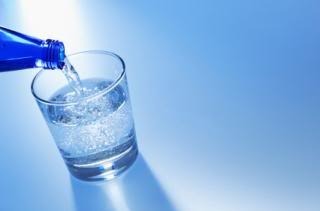 It’s time for another edition of “Is It Primal?” Judging from the endless stream of questions I receive regarding the suitability of certain foods and ingredients, I’m not sure I’ll ever run out of things to scrutinize. As always, though, know that no single food I cover in these posts will make or break your health. If I give an unfavorable verdict to one of your favorite foods, that doesn’t mean you have to banish it from your diet forever. It doesn’t mean the occasional dalliance will necessarily make something rotten in the state of your metabolism. It just means that, given the opportunity to choose between something (approved) like a slab of grass-fed beef, a pastured egg, some sautéed kale, or a sweet potato and something (not approved) like sourdough rye, I’d choose the former. You might not, and that’s fine.
It’s time for another edition of “Is It Primal?” Judging from the endless stream of questions I receive regarding the suitability of certain foods and ingredients, I’m not sure I’ll ever run out of things to scrutinize. As always, though, know that no single food I cover in these posts will make or break your health. If I give an unfavorable verdict to one of your favorite foods, that doesn’t mean you have to banish it from your diet forever. It doesn’t mean the occasional dalliance will necessarily make something rotten in the state of your metabolism. It just means that, given the opportunity to choose between something (approved) like a slab of grass-fed beef, a pastured egg, some sautéed kale, or a sweet potato and something (not approved) like sourdough rye, I’d choose the former. You might not, and that’s fine.
That said, let’s get down to it!
Soda Water
I love a good glass of sparkling water. It’s somehow more refreshing than regular flat water, and if you go for the high mineral content sparkling water, you’re getting a nice dose of bioavailable minerals (in the form our ancient ancestors likely got many of theirs, minus the bubbles). I never thought to see this asked on an “Is It Primal?” but here it is. Apparently there are some concerns about it interfering with digestion and fat loss. There’s also talk of it dissolving bones. Let’s take a look.
Carbonated water has no effect on bone remodeling in post-menopausal women (the group perhaps most at risk for osteoporosis). Subjects drank a liter of sodium-rich bubbly water a day for months without any ill effect. In fact, a calcium-rich carbonated water was able to improve calcium status and reduce parathyroid hormone (PTH can increase bone loss) in women.
Soda water may be moderately corrosive to tooth enamel. Sparkling mineral water is far less corrosive, especially high-calcium mineral water (though still more corrosive than flat water with the same mineral composition).
Contrary to reducing digestive ability, sparkling water can actually reduce indigestion and improve constipation, as one study showed. It’s worth noting that the sparkling water used in the study had greater amounts of minerals like calcium, magnesium, sodium, and potassium than the flat water; more bubbles wasn’t the only difference.
As for fat loss, if anything, carbonated water will improve it by increasing satiety when compared to flat water.
Plus, according to Robb Wolf (whom I always trust on matters of vice), drinking your liquor with soda water reduces the absolute amount of alcohol you need to get the desired effect. That’s always nice (and healthier).
Verdict: Primal.
Listerine
As much as people in the Primal health community tend to shy away from questionable conventional medical advice, Listerine appears to be a truly effective product. It has no fluoride (unless you buy the one with fluoride in it). It actually seems to be quite “natural,” containing some ethanol, or alcohol, plus a bunch of essential oils from a variety of medicinal plants and herbs, including thyme, wintergreen, eucalyptus, and peppermint. If you ignore the plastic bottle, child-safe lid, possible synthetic sources of said oils, and ubiquitous marketing, Listerine looks, tastes, and smells an awful lot like something a shaman would cook up in the Amazon somewhere.
Does it work?
According to one dentist who promotes both good nutrition, stress reduction, and modern dental interventions, Listerine can be part of an effective oral hygiene regimen but it should not be used as a final rinse because the acidity can dry out the mouth and cause the protective pellicle layer to wither away. If you’re going to use Listerine, sandwich it in between brushing and a final rinse of something more amenable to oral moisture retention. For what it’s worth Dr. Ellie supports the use of fluoride mouth rinses for this purpose, but not the consumption of fluoridated drinking water. Links between Listerine usage and oral cancer (if they’re causally related) can probably be attributed to users’ tendencies to use the mouthwash as a final – and thus acidic, drying, lingering – rinse.
As a standalone intervention, however, Listerine has mixed evidence. Some studies indicate that Listerine eradicates all oral bacteria within 30 seconds of swishing and can even be used to disinfect toothbrushes (although one study found that it was just as effective against the streptococcus mutans species as air drying). Seeing as how oral bacteria both contributes to and protects against dental disease depending on the composition of the oral ecology, wiping them all out with Listerine may have unwanted effects.
Verdict: Primal, if used properly as described in the links from Dr. Ellie above (tooth decay is not Primal). Not Primal, if used incorrectly and haphazardly.
Tamarind
Most people know tamarind from the oddly salty, sour candies eaten in Latin American and Southeast Asian countries, or perhaps the salty, sour sauce used in Indian cuisine, but the tamarind is a legitimate tropical fruit. It comes in pod form, pods which contain seeds. The seeds are discarded (or saved for planting) while the pulp of the pod is cherished for its medicinal and culinary qualities. You can often find bricks of pulverized tamarind pulp for sale in Asian or Indian markets, which you then reconstitute with a bit of water to make tamarind slurry. If you’re serious about Thai cooking, tamarind pulp is a must.
But “pod” might be worrisome to some people. With pods often come legumes, and we generally avoid legumes for their anti-nutritional profiles. Sure enough, tamarind has got some anti-nutritional factors, like phytates and tannins, but also some very beneficial characteristics. For one, tamarind is rich in vitamin C, thiamin, magnesium, plus a bunch of other nutrients (since it’s a food and all). Tamarind also has along and storied history as a medicine in its native countries. Ayurvedic, Southeast Asian, and West African traditions all use tamarind to help treat a number of ailments. That’s all well and good, but what does modern science say?
Tamarind can increase fluoride excretion, even from the bones. If you’re worried about fluoride intake, consider cooking with tamarind from time to time.
Tamarind extract has shown anti-inflammatory effects.
Tamarind fruit lowers total cholesterol and diastolic blood pressure in humans.
It’s not all spotless, though:
Being acidic, tamarind can damage tooth enamel; including some fermented shrimp paste (and really, who doesn’t include that with their tamarind?) mitigated the effect. Tamarind intake has also been linked to gallstone formation in an observational study from India.
Verdict: Primal. The benefits of using tamarind as a cooking ingredient (not a staple food to be chowed down on every day, though) appear to outweigh any potential negatives.
Chicory
Chicory is a cool plant with a lot of uses. The leaves are highly prized and edible and come in a couple varieties, including radicchio and Belgian endive. The roots are dried, powdered, and used as a coffee substitute or additive. A potent prebiotic fiber known as inulin can also be extracted from the chicory root.
The stuff seems pretty healthful overall, with a few exceptions:
Radicchio leaves contain tons of bioflavonoids. We don’t quite know what they do and more isn’t necessarily better, but they’re there and these types of plant compounds tend to have beneficial effects when consumed as part of a varied diet.
Endive is also high in phenolic compounds. Same story here – most likely beneficial when added to an overall varied diet.
Prebiotic inulin derived from chicory root has been useful against constipation in the elderly. It’s also improved the gut flora in constipated females. In healthy males without any bowel issues, however, adding 20 grams of chicory inulin a day only increased flatulence. Since laughter is a cheap, harmless way to improve health, increasing flatulence may be worthwhile. Other studies have found 10 grams to be the tolerable upper limit for chicory inulin in healthy people. Whatever you do, tread lightly and go slowly when dealing with chicory fiber. Chicory coffee substitute is made from roasted chicory root rich in inulin, so there’s a good chance drinking coffee made with chicory or replaced by chicory will provide a dosage of prebiotic inulin.
I see nothing wrong with moderate and smart (if it makes you fart, lower the dosage) usage of chicory, and a whole lot right.
Verdict: Primal.
Cherimoya
Cherimoya is a favorite of mine, albeit one that I rarely get to eat. I was first introduced to the fruit in Thailand, where I proceeded to eat them just about every day I was there. You cut the top off to reveal the silky smooth interior flesh which you consume rapidly with a spoon. When somewhat ripe, it’s got the texture of a pear. When really ripe, it’s like custard, earning it the moniker of custard apple. The best cherimoyas taste like pineapple mixed with peach mixed with banana. You can get them in the States, but they’re frozen or canned in sweet syrup and far inferior to the fresh fruit. I don’t even bother with it unless I’m eating it fresh.
Cherimoya is sweet, sure, but fruit isn’t quite the same as white sugar or high fructose corn syrup. Fruit comes with minerals and vitamins and antioxidants, giving it an altered metabolic effect (like honey). You can still eat too much of it, of course, but if you’re worried about cherimoya, I think you’re doing quite fine in the nutrition department.
The seeds of the cherimoya contain cytotoxic and genotoxic compounds that are being studied for their anti-cancer potential, but nobody eats those anyway.
If you have a latex allergy, you may get some cross-reactivity with the cherimoya.
Verdict: Primal, and be sure to eat them if you have access.
That’s it for today, folks. Thanks for reading and be sure to keep sending or writing in your suspicious foods!
Get All Three Primal Cookbooks, an Apron and More in The Primal Blueprint Chef Kit Today!

April 22, 2013
Dear Mark: HIIT, Omega-3s and Cooking, and Gluten-Free Baked Goods
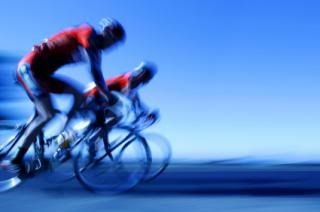 It’s time, yet again, for another edition of Dear Mark. As per usual, I’m doing a roundup of reader questions. First, I cover high intensity interval training, also known as HIIT. It’s the subject of an ongoing study that’s been getting a lot of play in the media, and, while we don’t have access to the as-yet-unpublished research, we do know a little something about HIIT from numerous other studies. Next, a reader asks about the effect of cooking on the omega-3 content and stability of salmon. I provide a bit of research and attempt to assuage his despondency about what he sees as a lack of reliable seafood. Finally, I give my take on the gluten-free baked goods phenomenon. Sure, it’s gluten-free, but does it belong in a Primal eating plan? Read on to see what I think.
It’s time, yet again, for another edition of Dear Mark. As per usual, I’m doing a roundup of reader questions. First, I cover high intensity interval training, also known as HIIT. It’s the subject of an ongoing study that’s been getting a lot of play in the media, and, while we don’t have access to the as-yet-unpublished research, we do know a little something about HIIT from numerous other studies. Next, a reader asks about the effect of cooking on the omega-3 content and stability of salmon. I provide a bit of research and attempt to assuage his despondency about what he sees as a lack of reliable seafood. Finally, I give my take on the gluten-free baked goods phenomenon. Sure, it’s gluten-free, but does it belong in a Primal eating plan? Read on to see what I think.
Let’s get to it:
Hi Mark,
I just watched a PBS special called The Truth About Exercise. Much of it was centered around a study being conducted in the UK concerning how long we really need to exercise during the week to obtain the necessary health benefits.
Currently the findings indicate that 3, 30 second bursts of exercise (bike, sprinting, rowing machine, etc.) followed by a rest period three times per week could be enough.
I’m assuming you’ve heard of this and are probably getting other emails. Just wondering what your thoughts are? Is it really enough and how do we define “enough”, i.e. is it enough to keep us fit, but perhaps not enough to get that toned/ripped look many are after? I’ve included a link to an article about the study. Thanks.
Is three minutes a week of exercise all you need to get fit?
Kristen
There’s not much available on this study, as it’s still ongoing, but I can give my thoughts on high intensity interval training (HIIT) in general.
In one study, two weeks of sprint interval training, for a total of six sessions, were enough to increase muscle oxidative potential (resting muscle glycogen content) and aerobic endurance capacity in trainees. Subjects performed four to seven 30 second “all out” cycling reps, each separated by four minutes of recovery time. VO2 max was not increased, but this strangely didn’t impact or impair their aerobic capacity, which “increased by 100%.” A mere fifteen minutes of actual sprint training was enough to double endurance capacity within two weeks’ time. Increasing your muscle glycogen content at rest also means a greater capacity for storing carbs as muscle energy, rather than having to convert them into body fat, which is nice and will help protect you from obesity.
In a 2007 study, researchers discovered that the metabolic adaptations produced by low-volume sprint training are remarkably similar to those produced by traditional endurance training. Two groups of “active but untrained” men and women – people who work out but aren’t athletes – were given six weeks of either sprint training or endurance training. Sprint training consisted of three weekly four to six rep sessions of 30 second sprints with 4.5 minute rests, while endurance training consisted of 45-60 minute continuous cycling sessions, done five times a week. The sprinters spent about one and a half hours each week (with most of that time spent resting, rather than actively sprinting) on the bikes, while the endurance subjects gave up four and a half hours each week (with most of that time spent pedaling). Despite the huge discrepancy in time commitments, there was no discernible difference in metabolic outcomes, causing the authors to conclude that sprint interval training is the more “time-efficient strategy” to obtain the benefits of endurance training.
Although long distance Chronic Cardio has always been touted as the best way to improve heart health, another HIIT study showed that sprint interval training is just as effective at improving arterial stiffness and flow-mediated dilation, two markers of endothelial function and helpful ways to predict heart health.
And how about actual performance outcomes? Another study found that low volume sprint interval training conferred rapid adaptations in skeletal muscle and exercise capacity – similar to those obtained via high volume endurance training.
Even if separate those 30 second sprint intervals with 20 second breaks, you still get an anabolic effect.
HIIT was recently shown to reduce ventricular scar tissue in a 50 year old heart attack patient. It took sixty weeks, but still – that’s pretty impressive.
And finally, a recent review of the evidence concluded that HIIT is “associated with increased patient compliance and improved cardiovascular and metabolic outcomes and is suitable for implementation in both healthy and ‘at risk’ populations.” In other words, high intensity interval training is well suited both for people who like to exercise and people who hate to exercise – and it’s extremely effective.
Yes, HIIT is a “shortcut” in that it allows you to gain many of the benefits of aerobic exercise without spending all the time we usually associate with “cardio,” but they are far from “easy.” One thing you should probably know about true intervals: they’re actually really, really hard! Like, puke-bucket-strategically-placed-near-the-stationary-cycle hard. You’re essentially cramming a couple hours’ worth of training into a few 30 second chunks. That’s one reason most HIIT studies use stationary bikes – they’re a bit safer for the average person to go all out on than running. If you’re trying to test the effects of HIIT in population of seniors, the last thing you want them to do is go out to the track and run sprints. Hamstrings will be flying all over the place like broken rubber bands. But, if you stick them on a stationary bike, even the most athletically-average person can get going at a very high clip without risking injury.
If you’re going to get the most out of HIIT, you really do have to push yourself. For an out of shape fifty year old, pushing oneself will look very different from a twenty year old athlete pushing herself. It’s all relative, and if you can’t run, you can swim, cycle, row, use the elliptical, or just about anything.
However, to answer your ultimate question: is it all we need? For me, no. I enjoy movement too much. Of course, I like to stay active by playing Ultimate and paddleboarding and snowboarding and hiking and playing with my family, with a bit of strength training and sprinting thrown in for good measure. Fun stuff, you know?
If you view exercise only as a means to an end? I’m still going with “no.” I happen to feel that lifting some heavy things and lots of slow moving are also crucial and even necessary for true fitness and health. I’m particularly skeptical about the the “active couch potato,” where you work out hard a few time a week but stay relatively sedentary the rest of the time, which this approach to HIIT as the exercise panacea seems like it might promote. But you could do a lot worse than focusing on HIIT, I suppose.
Hey Mark,
Really enjoy your articles, keep up the good work. Anyway, I was just wondering something since I couldn’t find an article on the matter.
According to your research does heating omega 3 fats above a certain temperature damage the fatty acids beyond repair? Because I didn’t feel I was getting any benefit from cooked salmon but when I eat gravlax I feel I’m getting much more benefit (general wellbeing, inflammation digestion and for candida/sibo).
However, getting safe raw seafood is pretty hard these days where I live. Shellfish has generally been preboiled before selling, raw fish has risk of parasites, caviar has been pasteurized, the gravlax is always farmed etc. It’s got to the point where I wonder if I would be better of just supplementing with cod liver oil or something.
Any thoughts on this?
Thanks,
Chris
Cooking salmon has been shown to increase the number of oxidative cholesterol products, but as long as you’re reasonable about it (don’t pan fry a salmon filet for 30 minutes or steam it until it’s mush or anything), the omega-3s should be well-preserved. A 2010 study on New Zealand king salmon found that raw, poached, steamed, microwaved, pan fried, baked, and even deep fried fish all showed “good preservation” of omega-3 fats. Deep frying caused the most damage, but it was relatively minor.
Refined, isolated omega-3 oils are much more susceptible to oxidation than whole foods containing them. Just 30 minutes of 150 ºF exposure was enough to degrade most of the EPA and DHA in fish oil, according to one study. However, adding the antioxidant-rich herbs rosemary and oregano to the oils prevented most of the degradation. Use a nice herby marinade next time you prepare salmon (and avoid deep frying it) and you’ll have double the protection for your omega-3s.
I would stick with food over supplements, whenever possible. Your seafood choices actually aren’t that bad. Boiled shellfish? Not the worst thing. You might assume I’m shucking raw oysters and steaming fresh mussels all the time, but I’m a big fan of canned smoked oysters and those frozen bags of (quick-steamed) mussels you get at Asian markets. Plus, boiling is one of the gentler cooking techniques, so there’s little danger of degradation. Just don’t subject the already-boiled shellfish to an inordinate amount of additional cooking and you’ll be fine. Parasites? Freeze your fish for a few days to take care of them. It’s what sushi restaurants do. Pasteurized caviar should be fine, too. It’d be great to get raw fish eggs, but it’s not the end of the world. While not ideal, farmed gravlax remains a good source of omega-3s. It’s certainly better than no fish at all.
All that said, raw is probably “better,” all else being equal, especially if you’re experiencing tangible benefits from it. You might try cooking your salmon faster or at lower temperatures, as well as using antioxidant-rich marinades to protect the fats, to see if that makes a difference in how you feel after eating it.
It seems like every grocery store now has a whole aisle full of ‘gluten-free’ foods – pastas, breads, cookies, etc. What are your thoughts in general on gluten-free baked goods and the like? Craving a grilled cheese sandwich, I recently picked up a loaf of gluten-free white sandwich bread that seemed to be made mostly of rice flour and tapioca, with other ingredients that didn’t seem too threatening. Where do you see foods like that, on a ‘frankenfood/ick’ to ‘meh/innocuous’ scale? Thanks!
Beth
They’re okay, and certainly better than the alternative. Just don’t go wild on them. Most gluten-free foods are devoid of nutrition, while the foods they’re trying to replace at least attempt to provide some nutrition (whole grains, whose nutrients may be highly bio-unavailable and accompanied by antinutrients like gluten, do contain nutrients on paper).
Here’s how I handle stuff like this: don’t “waste” your gluten-free treat excursions on empty calories. Make an awesome tomato meat sauce with bits of liver, extra virgin olive oil, and pecorino romano to get with your gluten-free pasta. Make a really good grilled cheese sandwich with aged gouda, some grass-fed butter for grilling, half an avocado, and maybe a few slices of bacon with your gluten-free bread. Get a gluten-free pizza crust and smother it in fresh pesto sauce, jumbo shrimp, and fresh mozzarella. Don’t just mindlessly eat gluten-free crackers, or snack on an entire loaf of plain gluten-free bread. Make it count, if you’re going to eat it. Make your gluten-free treat a vehicle for nutrient-dense food.
That’s all for today, folks. Thanks for reading, and let me know what you think in the comment board.
Limited Time Offer: Get a FREE Copy of The Primal Blueprint 90-Day Journal with Your Primal Essentials Kit Order

April 21, 2013
Weekend Link Love
 We’ve got a few openings for next month’s Primal Luxury Retreat in Malibu. Sign up for the weekend of your lifetime!
We’ve got a few openings for next month’s Primal Luxury Retreat in Malibu. Sign up for the weekend of your lifetime!
If you happen to be near Houston on May 3 and find yourself getting a little hungry (for food and good convo), consider attending the Primal supper with Mira and Jason Calton, as well as Keith and Michelle Norris of PaleoFX fame.
Research of the Week
Looks like grandmothers were actually crucial for human evolution. But, wait – how could that be if we all used to die at age 30?
A new, highly ironic study (PDF) concludes that “Compared with placebo or control, L-carnitine is associated with a 27% reduction in all-cause mortality, a 65% reduction in VAs, and a 40% reduction in anginal symptoms in patients experiencing an acute myocardial infarction.” See this related article if the irony is lost on you.
The occasional drink during pregnancy may not be that bad. Betty Draper redeemed, apparently. (But that doesn’t mean you should drink while pregnant, of course.)
Interesting Blog Posts
Why we eat whatever’s in front of us. Unless it’s cellulose that has yet to be converted into glucose, of course (see below).
Jeff Leach, of the Human Food Project, gives his take on the red meat scare study from last week, suggesting that the TMAO-producing gut flora profile “appears some how specific to the starch in grains or the dietary fiber in grains.”
Media, Schmedia
The news is bad for us, reports the news.
How scientists are looking to convert cellulose into starch to feed the world. Or, “Mmm, wood!”
A look at the world of Russ Kremer, who almost became a priest but ultimately chose sustainable pig farming.
Everything Else
No wonder humans seem to have a genetic proclivity toward fear of snakes: zombie rattlesnakes.
Lifehacker shows you how to invert your browser’s colors for easier reading at night. What also eases the eyes: sleep.
The gourmet cupcake market is crashing. I’d say this is evidence of people getting clued in to good health, but I wholly expect the personal pie market to soar in response.
Sleep is becoming lucrative, but probably not the way you’re thinking.
Recipe Corner
These honey mustard Cuban pork burgers may not truly be Cuban, but neither was Al Pacino, and Scarface worked out alright.
Speaking of Cuba, how about something with plantains in it? Paleo plantain beef pie sounds good.
Time Capsule
One year ago (Apr 21 – Apr 27)
2 More Common Nutrient Deficiencies (and What to Do About Them) – Are you missing out on these important nutrients? Find out inside.
What I Did Over Spring Break – In which I discuss my travels in South Africa, where I enjoyed many Primal meet-ups, including raw wildebeest dinner with lions mudbaths with elephants.
Comment of the Week
Looks so unbelievably wonderful! I hope I can attend one day. But…60F, cold? Sheesh, I would be perpetually drenched in perspiration!
- Okay, okay. We may be a bit spoiled out here. I’ll admit that.
Get All Three Primal Cookbooks, an Apron and More in The Primal Blueprint Chef Kit Today!

April 20, 2013
Tomato Soup with Spicy Mini-Meatballs
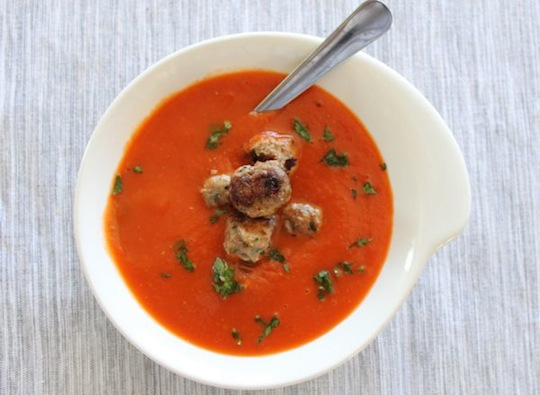
A bowl of tomato soup is delicious any time of year, for lunch or for dinner, for kids and adults. If fresh, super-ripe tomatoes aren’t available then this recipe for tomato soup made from canned tomatoes is the best one to follow. This homemade tomato soup has a rich, pure tomato flavor and silky texture. Like a much-improved version of Campbell’s.
A steaming bowl of tomato soup is one of life’s simple pleasures. The fact that this recipe is so easy to make with such great results is an added bonus. The soup turns out best with whole tomatoes (not chopped) because they have a flavor that’s most similar to fresh tomatoes. The quality of the canned tomatoes matters – choose a brand with a flavor you like and if you’re worried about BPA, stick with jarred or a BPA-free brand.
Served alone, this tomato soup makes a super-quick meal. But if you want to spice things up, drop a handful of spicy, mini-meatballs into the bowl, too. These delicious bite-sized mini meatballs are small enough to eat with a spoon (or by the handful).
This recipe makes a lot of tiny meatballs, close to 80, so you can cut the recipe in half if you like. But if you’re going to spend the time making meatballs, it makes sense to go all out. Extra meatballs can be frozen raw or cooked. Raw, frozen meatballs can cooked by dropping them directly into simmering sauce or soup. Cooked, frozen meatballs are best if frozen along with some soup or sauce, but can also be frozen alone and defrosted in the refrigerator.
Serves: 4 generous servings
Time in the Kitchen: Tomato Soup, 35 minutes. Meatballs, 1 hour.
Tomato Soup
Ingredients:
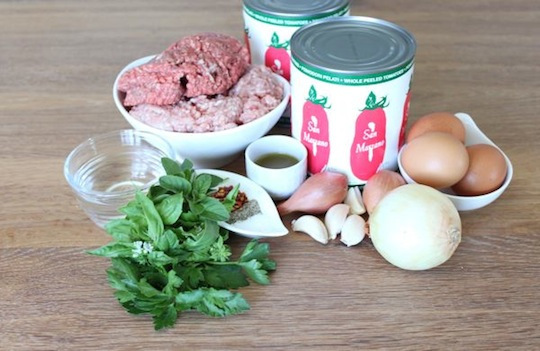
2 tablespoons extra virgin olive oil (30 ml)
2 garlic cloves, thinly sliced
1 small yellow onion, peeled and thinly sliced
2 (28 ounce) cans whole peeled tomatoes with juice (800 g)
1 1/4 cups water (300 ml)
1 tablespoon roughly chopped fresh oregano (15 ml)
1/2 teaspoon kosher salt (2.5 ml)
1/4 cup loosely packed fresh basil leaves (60 ml)
Instructions:
Warm the olive oil in a wide pot over medium-low heat. Add garlic and onion. Saute for 5 to 10 minutes to soften the onions. Keep an eye on the garlic so it doesn’t burn.
Add tomatoes with their juice, water, oregano and salt. Simmer for 30 minutes.
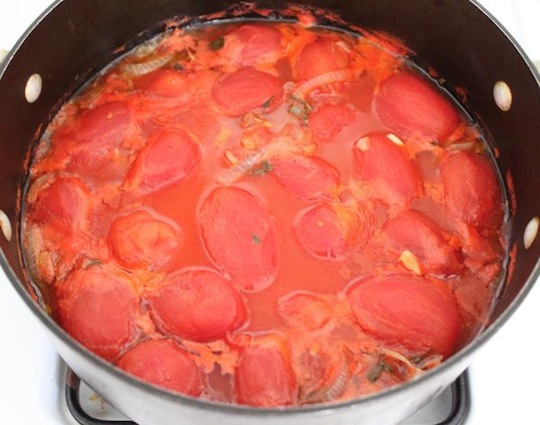
In two separate batches, pour the tomatoes and liquid into a blender and add the basil. Puree until very smooth. A high-powered blender will puree the soup so it has the same thin, silky texture of canned tomato soup. However, if the texture isn’t smooth enough for you, then strain the soup through a fine mesh strainer.
Add salt and pepper and additional fresh basil to taste.
Spicy Mini Meatballs
Ingredients:
2 tablespoons olive oil (30 ml)
2 shallots, finely chopped (or 1/2 an onion, finely chopped)
1 pound ground beef (450 g)
1 pound ground pork (450 g)
2 tablespoons finely chopped fresh basil (30 ml)
1/4 cup finely chopped fresh parsley (60 ml)
2 teaspoons salt (10 ml)
1 teaspoon black pepper (5 ml)
2 teaspoons crushed red pepper flakes (10 ml)
2 eggs, whisked
Coconut oil, to brown meatballs
Instructions:
Warm the olive oil in a skillet over medium heat. Add the shallots and garlic. Saute for 5 minutes, keeping an eye on the garlic so it doesn’t burn.
Scrap the shallots, garlic and olive oil into a large mixing bowl. Add the ground meat, fresh herbs, salt and both types of pepper. Combine the ingredients with your hands.

Pour the eggs into the meat and knead the meat well to completely combine the egg. You can add a third egg if desired, but if the meat seems really wet then skip the third egg.
Refrigerate the mixture for 15 minutes. This helps the meat absorb the egg and become less wet.
Preheat the oven to 375 ºF (190 ºC)
Use a measuring teaspoon to scoop individual teaspoons of meat in rows on a sheet pan. Once the meat is all measured out, lightly oil your hands and roll and pat/shape each scoop of meat into a tiny meatball.
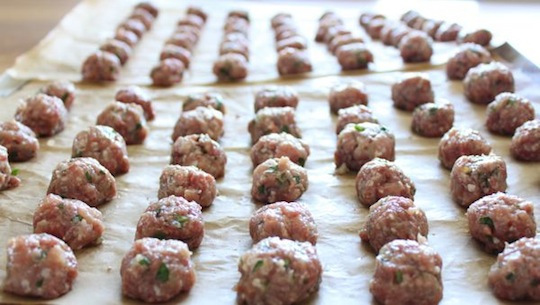
Tip: The easiest way to roll the meatball is to place the meat in the palm of one hand and use the three middle fingers of the other hand to roll it. If the meat begins to stick to your hand, wipe your palm clean with a paper towel then start rolling again.
Heat an oven-proof skillet with a little bit of coconut oil over medium heat. Add as many meatballs as will fit in the pan and brown for 1 to 2 minutes on each side.
Place the skillet in the oven to finish cooking the meatballs, 5 to 7 minutes.
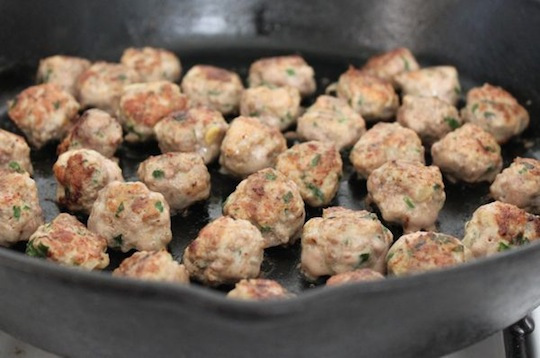
Or, transfer the browned meatballs to a sheet pan to bake and use the skillet to brown another batch.
Tip: The meatballs can be cooked entirely in the oven (without browning them in a pan first) on a baking sheet lined with parchment paper but they tend to ooze out a little moisture and don’t look as nice.
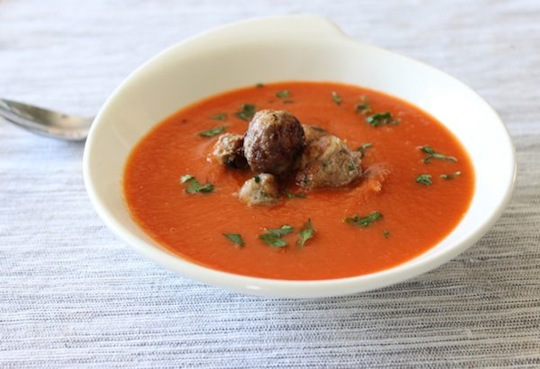
Not Sure What to Eat? Get the Primal Blueprint Meal Plan for Shopping Lists and Recipes Delivered Directly to Your Inbox Each Week

April 19, 2013
97 Pounds Destroyed!
It’s Friday, everyone! And that means another Primal Blueprint Real Life Story from a Mark’s Daily Apple reader. If you have your own success story and would like to share it with me and the Mark’s Daily Apple community please contact me here. I’ll continue to publish these each Friday as long as they keep coming in. Thank you for reading!
 Hello Mark,
Hello Mark,
My whole life changed because of the Primal Blueprint. Ever since I can remember, I struggled with weight. Unsure why at times, since both of my brothers had no problem being thin and built. My bodily make-up was apparently different.
I tried many diets over the years. Accompanied by many short stints with gyms and home workouts. I lost 10, 20, and even 30 lbs one time, and gained it all back with vengeance. When I was 24, I suffered a back injury that required surgery. From that day on, I was constantly in pain from my lower back.
As life went on, I began to believe that being a big guy was me. I grew to accept what, I felt, I could not change. I also grew to accept back pain as a way of life (sometimes crippling pain). At one point in my life I remember weighing in at 350. Below is a picture of what I had become – 339lbs.

Something about seeing this picture, triggered the biggest battle of my life. I left work one night and joined the nearest gym I got to. Once there, I was offered a trainer as part of the membership offer. If I was going to do this, I was going to do it full bore. Two days later, I started with a trainer and battled through every workout, till I had given it everything I had. As time went on, the workouts became easier and the bodily pain subsided. Back pain also greatly reduced.
I was put on a nutritional plan by my trainer. It was very similar to the low carb lifestyle of Primal Blueprint. However, it was very confusing to me and not very clear cut. I started making salads for lunch instead of ordering in at work. Pounds started to disappear. This transitioned my thought process into, how can I make it better? I checked out books on Amazon about how to lose weight and stumbled across your book. As I read through it I realized the similarities to my current plan. Only it had one key factor that I was missing; an understanding of how everything effects my body.
Two months later was weight check-in time. I had lost 38 lbs since this all began. This just gave me more drive. I was so close to dropping below 300 for the first time in, I don’t know how long.
I went out and bought a treadmill, weight machine, free weights and a rowing machine to build a home gym. I wanted something for the nights it was too late for the gym. I went a little overboard. Who would have thought, I’d convert my home bar into a gym.
I started experimenting with many Primal recipes. Concocting my own and spending free time searching Mark’s Daily Apple for new and exciting meals. I have eaten vegetables and fish that I have never tried in my life, and love it! I am always searching for new ideas.
With all the changes taking place, I decided to step it up a notch. After 16 years, I grew my hair back and shaved my goatee. I was surprised to find a full head of hair.
I even felt so ambitious that I signed up and started a 25 person team for the ToughMudder (inspired by British military training) in July. Twelve miles and twenty-five obstacles of Guns a Blazin’ Primal exercise. Everyone on our team must make it. When I make it through that will be when I feel I have completed what I set out to do.
And now 10 months later, I am weighing in at 242 lbs. 97 lbs destroyed!
I still have a long ways to go, but I’m getting there. Training hard for July. I just wanted to say thank you, Mark. Your book has inspired me to fight the toughest battle of my life and has changed it forever…

Thank you,
John
Subscribe to the Mark’s Daily Apple Newsletter and Get the Success Story in the Making eBook for Free

Mark Sisson's Blog
- Mark Sisson's profile
- 199 followers



